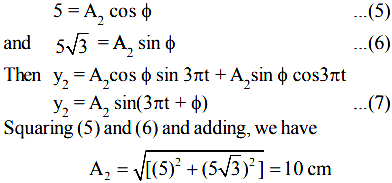Given equations are
y1 = 10 sin(π/4) (12t + 1) ...(1)
y2 = 5(sin 3πt + √3 cos 3πt) ...(2)
We recast these in the form of standard equation of SHM which is
y =A sin (ωt + ϕ) ...(3)
Equation (1) maybe written as
y1 = 10 sin[(12πt/4) + (π/4)]
y 1 = 10 sin[(3πt + π/4)] ...(4)
Comparing eqn. (4) with eqn. (3) we have
Amplitude of first SHM = A1 = 10 cm s –1 and ω1 = 3π
∴ Time period of first motion
T1 = 2π/ω1 = 2π/3π = (2/3) s
Eq. (2) may also be written as
y2 = 5sin 3πt + 5 √3 cos 3πt
Let us put

i.e. amplitude of second SHM = 10 cm
and time period of second SHM = T2
2π/ω2 = 2π/3π = 2/3 s
Thus, the ratio of amplitudes
A1 :A2 = 1 : 1 and periodic times are
T1 = T2 = (2/3) s